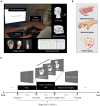2020 International brain-computer interface competition: A review
- PMID: 35937679
- PMCID: PMC9354666
- DOI: 10.3389/fnhum.2022.898300
2020 International brain-computer interface competition: A review
Abstract
The brain-computer interface (BCI) has been investigated as a form of communication tool between the brain and external devices. BCIs have been extended beyond communication and control over the years. The 2020 international BCI competition aimed to provide high-quality neuroscientific data for open access that could be used to evaluate the current degree of technical advances in BCI. Although there are a variety of remaining challenges for future BCI advances, we discuss some of more recent application directions: (i) few-shot EEG learning, (ii) micro-sleep detection (iii) imagined speech decoding, (iv) cross-session classification, and (v) EEG(+ear-EEG) detection in an ambulatory environment. Not only did scientists from the BCI field compete, but scholars with a broad variety of backgrounds and nationalities participated in the competition to address these challenges. Each dataset was prepared and separated into three data that were released to the competitors in the form of training and validation sets followed by a test set. Remarkable BCI advances were identified through the 2020 competition and indicated some trends of interest to BCI researchers.
Keywords: brain-computer interface (BCI); competition; electroencephalogram; neural decoding; open datasets.
Copyright © 2022 Jeong, Cho, Lee, Lee, Shin, Kweon, Millán, Müller and Lee.
Figures












Similar articles
-
Review of the BCI Competition IV.Front Neurosci. 2012 Jul 13;6:55. doi: 10.3389/fnins.2012.00055. eCollection 2012. Front Neurosci. 2012. PMID: 22811657 Free PMC article.
-
Adaptive LDA Classifier Enhances Real-Time Control of an EEG Brain-Computer Interface for Decoding Imagined Syllables.Brain Sci. 2024 Feb 21;14(3):196. doi: 10.3390/brainsci14030196. Brain Sci. 2024. PMID: 38539585 Free PMC article.
-
Evaluation of Hyperparameter Optimization in Machine and Deep Learning Methods for Decoding Imagined Speech EEG.Sensors (Basel). 2020 Aug 17;20(16):4629. doi: 10.3390/s20164629. Sensors (Basel). 2020. PMID: 32824559 Free PMC article.
-
Decoding Covert Speech From EEG-A Comprehensive Review.Front Neurosci. 2021 Apr 29;15:642251. doi: 10.3389/fnins.2021.642251. eCollection 2021. Front Neurosci. 2021. PMID: 33994922 Free PMC article. Review.
-
Recent Progress in Wearable Brain-Computer Interface (BCI) Devices Based on Electroencephalogram (EEG) for Medical Applications: A Review.Health Data Sci. 2023 Dec 19;3:0096. doi: 10.34133/hds.0096. eCollection 2023. Health Data Sci. 2023. PMID: 38487198 Free PMC article. Review.
Cited by
-
Posthoc Interpretability of Neural Responses by Grouping Subject Motor Imagery Skills Using CNN-Based Connectivity.Sensors (Basel). 2023 Mar 2;23(5):2750. doi: 10.3390/s23052750. Sensors (Basel). 2023. PMID: 36904950 Free PMC article.
-
Effect of natural and synthetic noise data augmentation on physical action classification by brain-computer interface and deep learning.Front Neuroinform. 2025 Feb 27;19:1521805. doi: 10.3389/fninf.2025.1521805. eCollection 2025. Front Neuroinform. 2025. PMID: 40083893 Free PMC article.
-
An Adaptive Task-Related Component Analysis Method for SSVEP Recognition.Sensors (Basel). 2022 Oct 11;22(20):7715. doi: 10.3390/s22207715. Sensors (Basel). 2022. PMID: 36298064 Free PMC article.
-
Identifying Thematics in a Brain-Computer Interface Research.Comput Intell Neurosci. 2023 Jan 4;2023:2793211. doi: 10.1155/2023/2793211. eCollection 2023. Comput Intell Neurosci. 2023. PMID: 36643889 Free PMC article. Review.
-
Non-Invasive Brain-Computer Interfaces: State of the Art and Trends.IEEE Rev Biomed Eng. 2025;18:26-49. doi: 10.1109/RBME.2024.3449790. Epub 2025 Jan 28. IEEE Rev Biomed Eng. 2025. PMID: 39186407 Free PMC article. Review.
References
-
- An S., Kim S., Chikontwe P., Park S. H. (2020). “Few-shot relation learning with attention for EEG-based motor imagery classification,” in 2020 IEEE/RSJ International Conference on Intelligent Robots and Systems (IROS) (Las Vegas, NV: IEEE; ), 10933–10938.
Publication types
LinkOut - more resources
Full Text Sources

